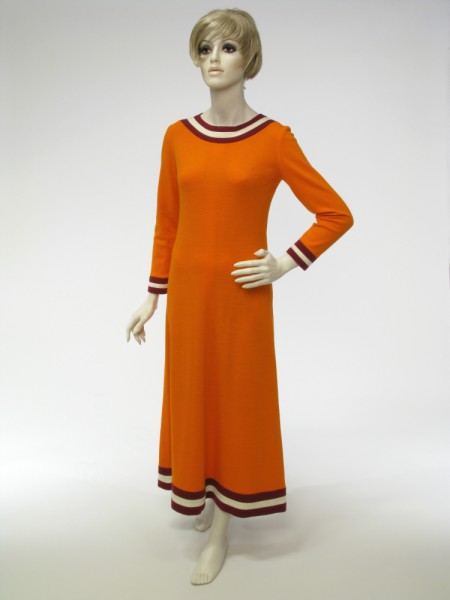evening dress
Summary
full-length dress in ginger jersey with wide boat neckline trimmed with a broad band of maroon and cream jersey; matching bands at hem and wrists. Princess, A-line with seams at sides, cf and cb (with long 20 in zip); bust darts. Unlined. Labels cb neck; "Pure new wool, jersey bonded to acetate" and "Mary Quant's Ginger Group" Worn by donor, Lilian Gethic, in Manchester from 1963 -5. Bought from Kendal Milne. (The Ginger Group first appeared in Autumn 1963; see Vogue 15/9/1963, pp100 - 103.)
Display Label
Although it is tempting to think of the 1960s in terms of a clear decade, in fashion terms it can actually be separated into two distinct halves, with the first few years allied to the styles of the 1950s, and the last half blasting a new provocative course. Mini-skirts and mini-dresses first appeared from 1965, shocking conservative society by concealing so little. English designers like Mary Quant, Ossie Clark and Bill Gibb led the world of fashion, so that the influence of London and its vibrant boutique street-life, was able to overtake that of Paris for a few brief years, although Courreges, Ungaro and Saint Laurent remained crucial figures. Simple mini-shifts or floor-length A-line evening gowns provided a perfect canvas for dramatic decoration, as in the 1920s. However, unlike those of the twenties, sixties designs tended to be printed, and often extremely colourful, in new psychedelic patterns. "Op Art" in bold black and white patterns, as featured in the dress illustrated, was also very popular, and still is today, as seen by the top from 2004 shown below. Menswear was also far more imaginative in the later 1960s than the previous decades, with bright colours and patterns, and sleek fitted styling. New man-made fabrics were introduced, including nylon for men's shirts, crimplene for jackets and coats, PVC for rainwear and decorative trims, and even paper for mini dresses (see below). Knitting and crochet also had a major revival, particularly for women's mini-dresses, hats and jumpers.
Object Name
evening dress
Creators Name
Date Created
1963
Dimensions
Bust: 88cm
Cuff (inside edge): 21.5cm
Hem circumference: 167cm
Hip: 90cm
Length:
Sleeve overarm: 58cm
Sleeveunderarm: 41cm
Waist to hem: 94cm
across shoulders: 35cm
bustpoint to bustpoint: 22cm
nape to hem: 129cm
nape to waist: 35cm
waist to bustpoint: 19cm
waist: 80cm
accession number
1995.116
Collection Group
Place of creation
London
Medium
Legal
© Manchester Art Gallery


